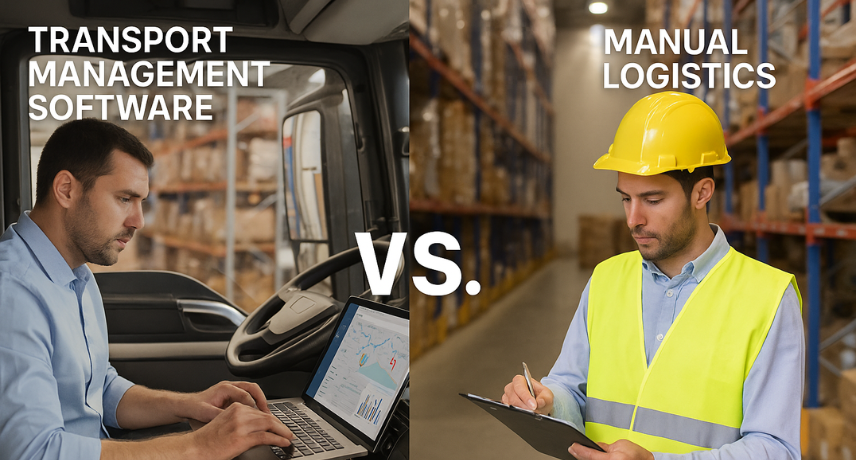
Enquiry Form
Transport Management Software vs. Manual Logistics: Which Is Better for SMEs?
Small and medium businesses (SMEs) have a question to answer for their logistics operations continue to rely on traditional manual processes or move to modern transport management software. As businesses scale and customer demands increase, it becomes increasingly important to consider which logistics management process will keep them ahead of the competition and allow them to operate at their most efficient.
Exploring Transport Management Software for an SME
Transport management software is a broad category of solutions designed to integrate various logistics operations in planning to delivery. Unlike manual systems where separate sheets were maintained for some functions, manual telephone calls for some, and paper for others, these software platforms centralize multiple logistics functions within one single interface for easy use.
Modern logistics automation for SMEs covers route optimization, real-time tracking, scheduling automation, and electronic documentation. It is a great transformer in handling transport challenges by giving visibility and control that was unimaginable in the past into supply chain operations.
Efficiency in Modern Operations
In any contemporary setup, efficiency tools include GPS tracking, automated dispatch, and predictive analytics. With such features, SMEs track the performance of the fleet, work on route de-optimization, and avert disruptions before they can affect operations.
Transport billing software is capable of automatic invoice generation, payment tracking, and customer account management in these platforms.
Working on the Manual Logistics Approach: It is the sphere of traditional methods.
Logistics are symbolic of human activity and human endeavor, depending on paper documentation and scant communications. Many SMEs continue to opt for such a system because of familiarity with it, perceiving it as cheaper, or simply being resistant to technological advancement.
Usual Manual Logistics Implementation
In general, traditional logistics might involve dispatching by phone, paper route sheets, manual invoice production, and tracking by spreadsheets. Dispatchers direct drivers via radio or mobile phones, while paper forms attest delivery confirmations.
Administrative Hitches in Manual Setups
Processing in manual mode is time-consuming for staff given data entry, route plotting, and requisite interaction with customers. It involves the staff manually entering the state of operations on deliveries, putting together invoices, and talking with customers, none of which can be seen in real time.
Comprehensive Transport Management Software Comparison
When evaluating the factors for comparing transport management software, SMEs keep in mind functionality, scalability, potential integrations, and the total cost of ownership. Such contemporary solutions have the choice to be installed on the cloud and are mobile-accessible, with potential integrations to existing business systems.
Cost Analysis: Software Investment vs. Manual Operation
While manual logistics looks cost-effective at face value, hidden costs pile up through inefficiencies, errors, and lost opportunities. Increased efficiencies and lowered operational overheads usually allow the investment in the software to be recouped the first year after automating logistics.
Typically, transport management software cuts down fuel costs by 10-15%, based on route optimization; administrative working time by 30-40%; and on-time delivery rates by 20-25%. These quantifiable factors completely influence the bottom line and customer satisfaction."
ROI Calculations
Typically, any SME investing in logistics automation profitably sees its ROI within a period of 12-18 months. The savings comprise fuel cost reductions, administrative cost reductions, and better vehicle utilizations.
Efficiency in Operations: Automation vs. Manual Procedures
For SMEs, logistics automation offers a number of operational benefits over manual techniques. Real-time tracking eliminates the need for time-consuming status update calls, and automated route optimization can cut travel time by 20%.
Digital platforms give users immediate access to performance metrics, customer communications, and delivery confirmations. Data-driven decision-making and proactive customer service are made possible by this transparency.
Scalability Issues for Expanding SMEs
As businesses expand, manual logistics systems become less and less effective. Human-based systems find it difficult to handle the exponential complexity that comes with adding more routes, cars, or clients.
As a company grows, transport management software adapts easily to handle more cars, routes, and clients without requiring corresponding increases in administrative burden.
Making the Right Choice for Your SM
The choice between manual logistics and transport management software hinges on competitive positioning, customer expectations, business size, growth path, and growth potential. SMEs with over 50 deliveries per week usually gain greatly through automation.
Assess the options based on current operational agony points, budget currently available, technical skills of staff, and long-term business goals.
Implementation Strategy and Timeline
Effective implementation of software calls for good planning, training personnel, and phased deployment. The majority of SMEs can migrate to automated systems within 30-60 days with proper assistance and change management.
Conclusion:
In conclusion, securing your logistics operations for the future
Through increased productivity, lower costs, and better customer service, transport management software gives SMEs a number of advantages over manual logistics. Even though the initial outlay might seem high, for the majority of expanding businesses, the long-term advantages greatly exceed the costs.
Competitive advantage, operational excellence, and sustainable growth are all made possible by modern logistics efficiency tools. Businesses that adopt automation put themselves in a successful position in a market that is becoming more and more demanding.
Are you prepared to revamp your logistics business? To find the ideal transport management software for your small business, get in touch with Softwares in Demand right now. Our professionals will assist you in planning implementation, weighing your options, and achieving quantifiable increases in productivity and profitability.